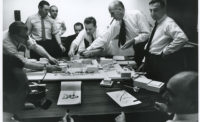A feature film based on a young adult novel is undoubtedly an abnormal place for an architecture conversation. But a teen-driven coming-of-age movie and its YA source material? Certainly among the last places you’d expect to find the influence of Buckminster Fuller. And yet, here’s The House of Tomorrow, writer-director Peter Livolsi’s adaptation of Peter Bognanni’s 2010 book, in limited release beginning April 27.
The film is fairly typical of the genre: Two mismatched teens—the affectless, clinical Sebastian (Asa Butterfield) and the angry, rebellious Jared (Alex Wolff)—meet, teach each other about the world and themselves, and through punk music forge a lifelong friendship. There’s also requisite tragedy and trauma: Sebastian’s parents died in a plane crash, leaving him the charge of his grandmother Josephine (Ellen Burstyn); Jared recently had a heart transplant, leaving his father Alan (Nick Offerman) and sister Meredith (Maude Apatow) constantly dreading his body will reject the new organ.
Tomorrow’s typical teen tableau veers hard into the unexpected, though, framed as it is by the philosophy, legacy, and architecture of Bucky Fuller. Sebastian and Josephine live in and give tours of a geodesic dome residence in Minnesota, and Josephine, a true-believer Fuller acolyte, wants to transform the house into a regional center dedicated to the architect. But her unquestioning embrace of the architect’s far-out futurism earns her a reputation as a local eccentric. In Sebastian, though, she has groomed Guinea Pig S, structuring a “dynamic, independent way to live” built around Fuller’s teachings—and excluding everyday teen experiences like grilled cheese, TV, and girls.
Sebastian’s Bucky-based homeschooling gives him a unique kind of empathy, finding connections between experiences others more often miss. He also draws on the architect when crafting punk lyrics, an undeniably outside-the-box application of Fuller’s ideas. But by encasing the teen in a hermetically-sealed geodesic cocoon, Josephine robs Sebastian of the kind of engagement with Spaceship Earth that allowed Fuller to formulate and evolve his worldview in the first place. And by wallowing in her idealized fantasy of Bucky, Josephine hardens into a rigid zealot, fetishizing the past even as she chastises her grandson for, at times, looking backwards.
Blind nostalgia is the enemy of creativity—and relationships—and the effect Josephine and her biases have on Sebastian and his friendship with Jared is by turns powerful, heartbreaking, and rousing. Butterfield and Wolff are excellent—in their own roles and together—and Tomorrow works because their relationship is always authentic and relatable. But Burstyn, as the film’s antagonist, connects with viewers on a more primal level. The Oscar winner was a friend of Fuller’s, and her firsthand experience with Bucky and his dogma (she appears in archival footage alongside the architect asking him to point toward the future) allows Burstyn to masterfully embody the challenge Fuller’s legacy presents in the film: how to retain your identity and allegiance to an ethos while openly engaging with an increasingly unrecognizable world.
Befitting the YA genre, the characters in The House of Tomorrow grow and come to a place of common understanding, made better by putting aside biases and expanding their lives to accomodate more people, viewpoints, and experiences. And that includes how Josephine and Sebastian grapple with Buckminster Fuller.
At the start of the film, he’s a visage on a screen, an unchanging collection of texts on a shelf, an echo of the past haunting their geodesic dome. By the end, the spirit of teenage rebellion has reanimated and breathed new life into the deified architect: “Bucky’s a punk,” Sebastian says.






Post a comment to this article
Report Abusive Comment